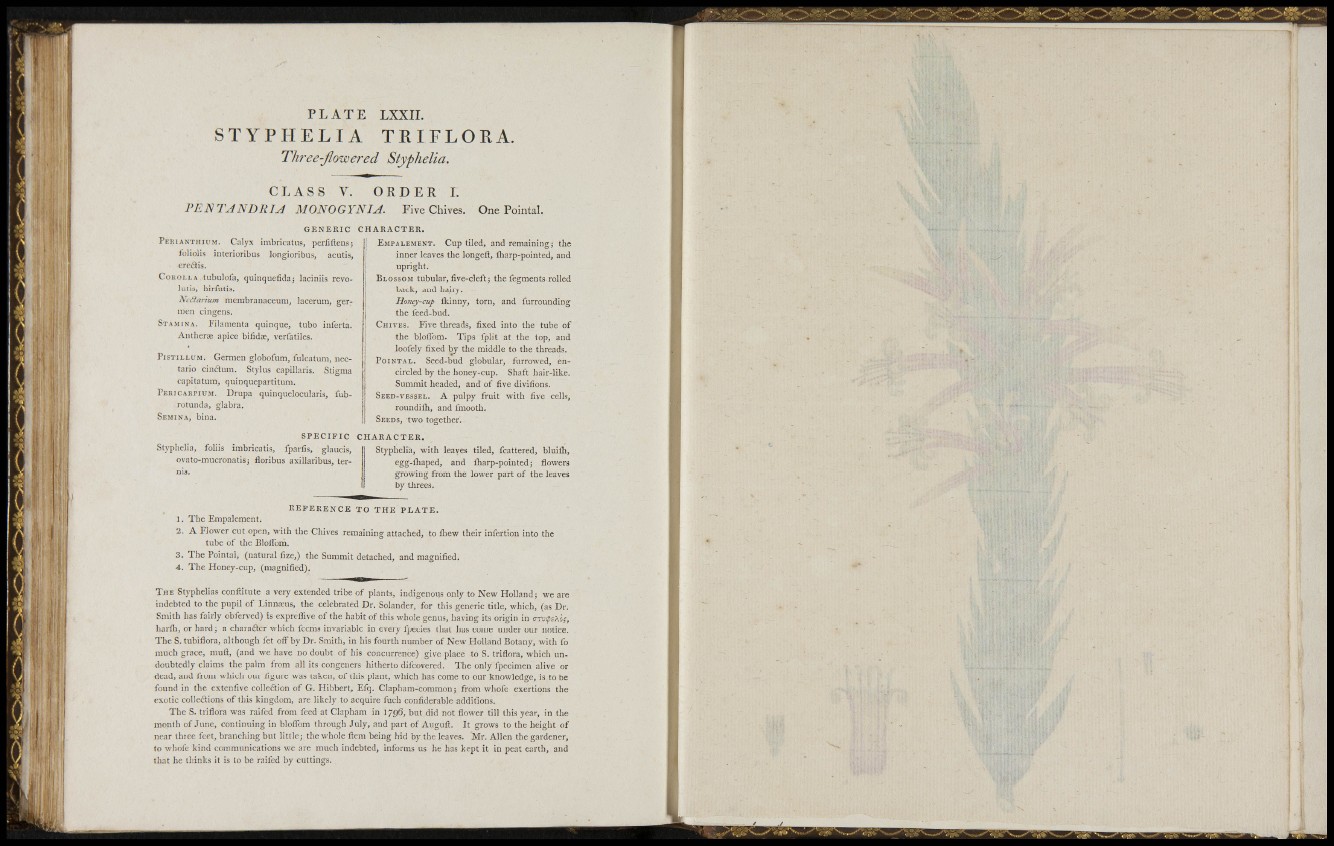
TT
íi
I
I
à ïj; iiiií
mi
• -í-t '
: ' I i
P L A T E LXXII.
S T Y P H E L I A TRIFLORA.
Three-flowered Styphelia.
C L A S S V. ORDER I.
PENTANDRI^ MONOGYNIJ. Five Chives. One Pointal.
GENERIC
PEKIANTHILIM. Calyx imbricatas, perliftens;
iolioUs iiiterioribus longioribus, acutis,
ercòlis.
COKOLLA tubulola, quinquefida; laciniis revolutis,
hirfntis. Ncéìarium membranaceum, lacerura, germen
cingens.
STAMINA. Filaiuenta quinqué, tubo inferta.
Anthera; apice bifidce, verfatiles.
P I S T I L L U M . Germen globofum, fulcatum, nectario
cinélum. Stylus capiilaris. Stigma
capi ta turn, quinquepartitum.
PEKiCAiinuM. Drupa quinquelocularis, fubrotunda,
glabra.
SEMINA, bina.
SPECIFIC
Slyphelia, foliis imbrica tis, fparlis, glaucis,
ovato-mucronatis; floribus axillaribus, ternis.
CHARACTER.
EMPALEMENT. Cup tiled, and remaining; the
inner leaves the longeft, lliarp-pointed, and
upright.
BLOSSOM tubular, five-cleft; the fegments rolled
back, and hairy. ihney-cup ikinny, torn, and furrounding
the feed-bud.
CHIVES. Five threads, fixed into the tube of
the bloflbm. Tips fplit at the top, and
loofely fixed by the middle to the threads.
P O I N T A L . Seed-bud globular, farrowed, encircled
by the honey-cup. Shaft hair-like.
Summit headed, and of five divifions.
SEED-VESSEL. A pulpy fruit with five cells,
roundifli, and fmooth.
SEEDS, two together.
CHARACTER.
Styphelia, with leaves tiled, fcattered, bluilli,
egg-fliaped, and fharp-pointed; flowers
growing from the lower part of the leaves
by threes.
EEFEEENCE TO THE PLATE.
1. The Empalement.
2. A Flower cut open, with the Chives remaining attached, to fliew their infertion into the
tube of the Bloflbm.
3. The Pointal, (natural fize,) the Summit detached, and magnified.
4. The Honey-cup, (magnified).
THE Styphehas conftitiite a very extended tribe of plants, indigenous only to New Holland; we are
indebted to the pupil of l-innreus, the celebrated Dr. Solander, for this generic title, which, (as Dr.
Smith has fairly obferved) is exprcflive of the habit of this whole genus, having its origin in trru^sASf,
liarfli, or hard; a charafter wliich feems invariable in every fpecies that has come under cur notice.
The S. tubiflora, although fet off by Dr. Smith, in his fourth number of New Holland Botany, with fo
much grace, muft, (and we have no doubt of his concurrence) give place to S. triflora, which undoubtedly
claims the palm from all its congeners hitherto difcovered. The only fpecimen alive or
dead, and from which our figure was taken, of this plant, which has come to our knowledge, is to be
found in the extenfive colle6tion of G. Hibbert, Efq. Clapham-common; from whofe exertions the
exotic colleitions of this kingdom, are likely to acquire fuch confiderable additions.
The S. triflora was raifed from feed at Clapham in but did not flower till this year, in the
month of June, continuing in bloiTom through July, and part of Auguft. It grows to the height of
near thice feet, branching but little; the whole ilem being hid by the leaves. Mr. Allen the gardener,
to whofe kind communications we are much indebted, informs us he has kept it in peat earth, and
that he thinks it is to be raifed by cuttings.
• V
!
1 Ì
i
J
1
i J'